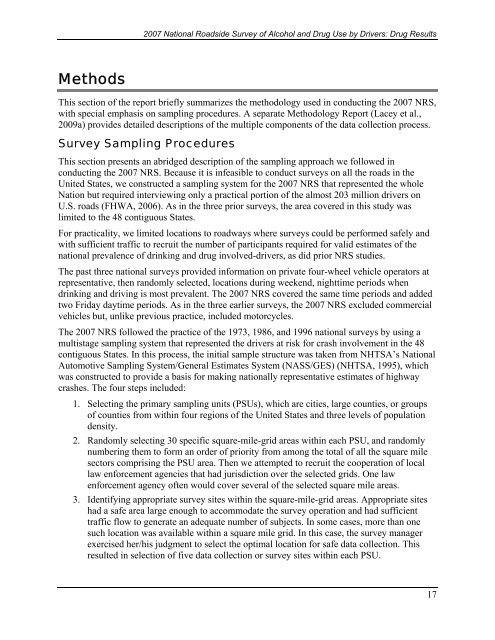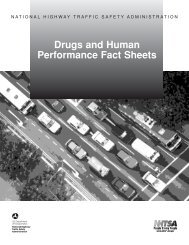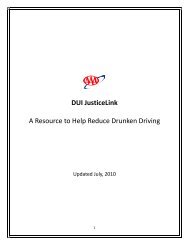2007 National Roadside Survey of Alcohol and Drug Use by Drivers
2007 National Roadside Survey of Alcohol and Drug Use by Drivers
2007 National Roadside Survey of Alcohol and Drug Use by Drivers
Create successful ePaper yourself
Turn your PDF publications into a flip-book with our unique Google optimized e-Paper software.
<strong>2007</strong> <strong>National</strong> <strong>Roadside</strong> <strong>Survey</strong> <strong>of</strong> <strong>Alcohol</strong> <strong>and</strong> <strong>Drug</strong> <strong>Use</strong> <strong>by</strong> <strong>Drivers</strong>: <strong>Drug</strong> ResultsMethodsThis section <strong>of</strong> the report briefly summarizes the methodology used in conducting the <strong>2007</strong> NRS,with special emphasis on sampling procedures. A separate Methodology Report (Lacey et al.,2009a) provides detailed descriptions <strong>of</strong> the multiple components <strong>of</strong> the data collection process.<strong>Survey</strong> Sampling ProceduresThis section presents an abridged description <strong>of</strong> the sampling approach we followed inconducting the <strong>2007</strong> NRS. Because it is infeasible to conduct surveys on all the roads in theUnited States, we constructed a sampling system for the <strong>2007</strong> NRS that represented the wholeNation but required interviewing only a practical portion <strong>of</strong> the almost 203 million drivers onU.S. roads (FHWA, 2006). As in the three prior surveys, the area covered in this study waslimited to the 48 contiguous States.For practicality, we limited locations to roadways where surveys could be performed safely <strong>and</strong>with sufficient traffic to recruit the number <strong>of</strong> participants required for valid estimates <strong>of</strong> thenational prevalence <strong>of</strong> drinking <strong>and</strong> drug involved-drivers, as did prior NRS studies.The past three national surveys provided information on private four-wheel vehicle operators atrepresentative, then r<strong>and</strong>omly selected, locations during weekend, nighttime periods whendrinking <strong>and</strong> driving is most prevalent. The <strong>2007</strong> NRS covered the same time periods <strong>and</strong> addedtwo Friday daytime periods. As in the three earlier surveys, the <strong>2007</strong> NRS excluded commercialvehicles but, unlike previous practice, included motorcycles.The <strong>2007</strong> NRS followed the practice <strong>of</strong> the 1973, 1986, <strong>and</strong> 1996 national surveys <strong>by</strong> using amultistage sampling system that represented the drivers at risk for crash involvement in the 48contiguous States. In this process, the initial sample structure was taken from NHTSA’s <strong>National</strong>Automotive Sampling System/General Estimates System (NASS/GES) (NHTSA, 1995), whichwas constructed to provide a basis for making nationally representative estimates <strong>of</strong> highwaycrashes. The four steps included:1. Selecting the primary sampling units (PSUs), which are cities, large counties, or groups<strong>of</strong> counties from within four regions <strong>of</strong> the United States <strong>and</strong> three levels <strong>of</strong> populationdensity.2. R<strong>and</strong>omly selecting 30 specific square-mile-grid areas within each PSU, <strong>and</strong> r<strong>and</strong>omlynumbering them to form an order <strong>of</strong> priority from among the total <strong>of</strong> all the square milesectors comprising the PSU area. Then we attempted to recruit the cooperation <strong>of</strong> locallaw enforcement agencies that had jurisdiction over the selected grids. One lawenforcement agency <strong>of</strong>ten would cover several <strong>of</strong> the selected square mile areas.3. Identifying appropriate survey sites within the square-mile-grid areas. Appropriate siteshad a safe area large enough to accommodate the survey operation <strong>and</strong> had sufficienttraffic flow to generate an adequate number <strong>of</strong> subjects. In some cases, more than onesuch location was available within a square mile grid. In this case, the survey managerexercised her/his judgment to select the optimal location for safe data collection. Thisresulted in selection <strong>of</strong> five data collection or survey sites within each PSU.17




